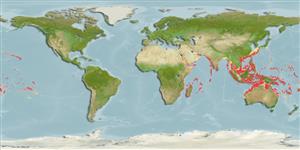Classification / Names
Common names from other countries
Main reference
Size / Weight / Age
Max length : 150 cm TL male/unsexed; (Ref. 1479); common length : 30.0 cm SL male/unsexed; (Ref. 7017); common length :45.5 cm SL (female); max. published weight: 18.0 kg (Ref. 13337); max. reported age: 44 years (Ref. 72487)
Length at first maturity
Lm ?, range 25 - ? cm
Environment
Marine; freshwater; brackish; benthopelagic; amphidromous; depth range 50 - ? m (Ref. 2847)
Climate / Range
Tropical; 22°C - 24°C (Ref. 2060), preferred 28°C (Ref. 107945); 34°N - 28°S, 16°E - 130°W
Distribution
Indo-Pacific: Persian Gulf (Ref. 68964), Red Sea and Natal, South Africa (Ref. 3969) to the Society Islands, north to southern Korea, south to the Arafura Sea (Ref. 9819) and New South Wales. Restricted to high islands (Palau, Caroline and Mariana islands) in Micronesia. Reported as far inland as the lower Shire in Malawi and the Save-Runde junction in Zimbabwe (Ref. 7248). Widespread in the Lower Zambezi River channels up to Marromeu and in the Micelo River up to Malingapanzi (Ref. 39494). South China Sea, Taiwan Strait, and East China Sea(Ref.33302).
Countries | FAO areas | Ecosystems | Occurrences | Introductions
Short description
Dorsal
spines
(total): 0;
Dorsal
soft rays
(total): 16-21;
Anal
spines: 0;
Anal
soft rays: 23 - 31. Lower jaw projects beyond snout; a bony gular plate present between the jaw bones. Last fin ray of dorsal long and filamentous; ventrally located pectoral fins; abdominal pelvic fins with 9 or more rays. Branchiostegals more than 23. Scales large. Color blue-green dorsally; silvery on sides. Can tolerate oxygen-poor water by `breathing' air into a lung-like air bladder. Also Ref. 3969.
IUCN Red List Status (Ref. 115185)
Threat to humans
Harmless
Human uses
Fisheries: minor commercial; aquaculture: commercial; gamefish: yes
Tools
Special reports
Download XML
Internet sources
Estimates of some properties based on models
Phylogenetic diversity index
PD50 = 1.0020 many relatives (e.g. carps) 0.5 - 2.0 few relatives (e.g. lungfishes)
Trophic Level
3.5 ±0.1 se; Based on diet studies.
Resilience
Medium, minimum population doubling time 1.4 - 4.4 years (Assuming tm<=4)
Vulnerability
High to very high vulnerability (67 of 100)
Price category
